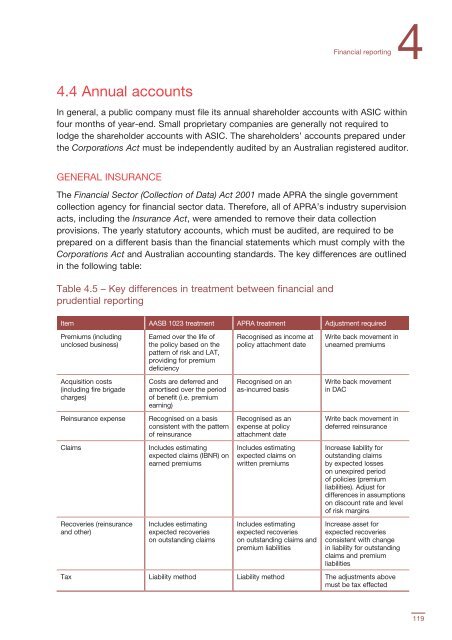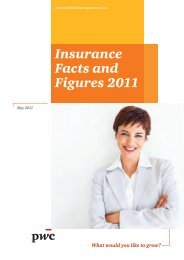Insurance facts and figures 2007 - PwC
Insurance facts and figures 2007 - PwC
Insurance facts and figures 2007 - PwC
You also want an ePaper? Increase the reach of your titles
YUMPU automatically turns print PDFs into web optimized ePapers that Google loves.
Financial reporting<br />
4<br />
4.4 Annual accounts<br />
In general, a public company must file its annual shareholder accounts with ASIC within<br />
four months of year-end. Small proprietary companies are generally not required to<br />
lodge the shareholder accounts with ASIC. The shareholders’ accounts prepared under<br />
the Corporations Act must be independently audited by an Australian registered auditor.<br />
GENERAL INSURANCE<br />
The Financial Sector (Collection of Data) Act 2001 made APRA the single government<br />
collection agency for financial sector data. Therefore, all of APRA’s industry supervision<br />
acts, including the <strong>Insurance</strong> Act, were amended to remove their data collection<br />
provisions. The yearly statutory accounts, which must be audited, are required to be<br />
prepared on a different basis than the financial statements which must comply with the<br />
Corporations Act <strong>and</strong> Australian accounting st<strong>and</strong>ards. The key differences are outlined<br />
in the following table:<br />
Table 4.5 – Key differences in treatment between financial <strong>and</strong><br />
prudential reporting<br />
Item AASB 1023 treatment APRA treatment Adjustment required<br />
Premiums (including<br />
unclosed business)<br />
Acquisition costs<br />
(including fire brigade<br />
charges)<br />
Reinsurance expense<br />
Claims<br />
Recoveries (reinsurance<br />
<strong>and</strong> other)<br />
Earned over the life of<br />
the policy based on the<br />
pattern of risk <strong>and</strong> LAT,<br />
providing for premium<br />
deficiency<br />
Costs are deferred <strong>and</strong><br />
amortised over the period<br />
of benefit (i.e. premium<br />
earning)<br />
Recognised on a basis<br />
consistent with the pattern<br />
of reinsurance<br />
Includes estimating<br />
expected claims (IBNR) on<br />
earned premiums<br />
Includes estimating<br />
expected recoveries<br />
on outst<strong>and</strong>ing claims<br />
Recognised as income at<br />
policy attachment date<br />
Recognised on an<br />
as-incurred basis<br />
Recognised as an<br />
expense at policy<br />
attachment date<br />
Includes estimating<br />
expected claims on<br />
written premiums<br />
Includes estimating<br />
expected recoveries<br />
on outst<strong>and</strong>ing claims <strong>and</strong><br />
premium liabilities<br />
Write back movement in<br />
unearned premiums<br />
Write back movement<br />
in DAC<br />
Write back movement in<br />
deferred reinsurance<br />
Increase liability for<br />
outst<strong>and</strong>ing claims<br />
by expected losses<br />
on unexpired period<br />
of policies (premium<br />
liabilities). Adjust for<br />
differences in assumptions<br />
on discount rate <strong>and</strong> level<br />
of risk margins<br />
Increase asset for<br />
expected recoveries<br />
consistent with change<br />
in liability for outst<strong>and</strong>ing<br />
claims <strong>and</strong> premium<br />
liabilities<br />
Tax Liability method Liability method The adjustments above<br />
must be tax effected<br />
119
















